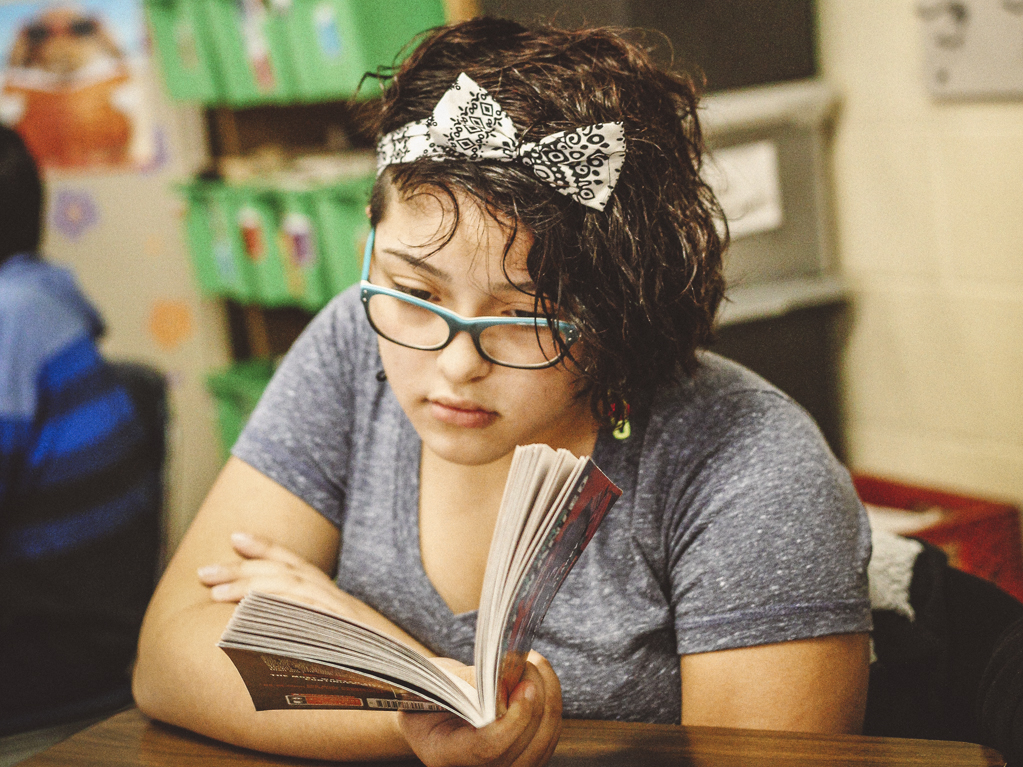
9 Ways to Get Teens Reading
Parents know how to inspire a love of books in babies and toddlers: Just put ’em on your lap, and start reading. But as kids get older and go to school, reading can be seen as work rather than fun — and kids, especially teens, may stop reading for pleasure. Here are nine ways to get teens reading, either again or for the first time.
- Find the “why” in YA. YA (young adult) novels tackle the edgy issues teens struggle with, from peer pressure and romantic longing to grief and trouble at home or school. Whether they’re personally grappling with these issues or seeking vicarious thrills, teens gravitate toward subject matter that’s relatable. Check the YA bestseller lists and our book reviews for ideas.

- Merge movies with books. Hollywood is turning to teen lit for ideas more than ever. Offer your teen the print version to read before or after a big film adaptation comes out, and talk about the similarities and differences between the two.
- Get graphic. Gone are the days when graphic novels were dismissed as comic books. Now recognized as literature, they may be the key to getting some teens hooked on books. They’re available in a wide range of genres — from adventure and fantasy to historical fiction, memoir, and biography — so certainly there’s a graphic novel out there to suit your teen’s taste. See our editors’ picks for Graphic Novels and Graphic Novels That Teach History.
- Lure ’em with adult books. Find nonfiction titles on subjects your teen’s curious about, such as climate change, race, political corruption, or true crime. Check adult nonfiction bestseller lists to see what’s catching fire. Funny adult books also work (by David Sedaris or Tina Fey, for example), as do horror (Stephen King), mysteries (Agatha Christie), thrillers (James Patterson, John Grisham), fantasy (George R.R. Martin), science fiction (Isaac Asimov), and sports (Michael Lewis).
- Try poetry. Novels in verse are a popular trend. All that white space on the page makes them easy to read, and the spare, lyrical approach can really pack a punch. Try Sarah Crossan’s One, Stasia Ward Kehoe’s The Sound of Letting Go, or Ellen Hopkins’ Rumble. Memoirs in verse are taking hold, too; check out Marilyn Nelson’s How I Discovered Poetry.

- Let them listen. Spark teens’ interest by getting an audio book to listen to on the way to school or on long drives. Let them download audiobooks to their smartphones. (They won’t risk looking uncool, because they’ll be under headphones or have their earbuds in.)
- Model reading. Read at home where your teens can see you. Talk about what you’re reading, and express your enjoyment. Always take a book or magazine along when you go to the beach or face waiting in a long line. Send your teen the message that reading is a pleasure, not a chore.
- Keep reading material around. Kids who grow up with lots of books around tend to read more. Stock the bathroom, car, dining table — wherever there’s a captive audience — with comic books, graphic novels, and magazines geared to your teens’ interests; first books in hit YA series; or classic sci-fi and mysteries. There’s nothing wrong with “micro-reading.”
- Give the gift of reading. Hand your teen a gift card to your local bookstore. They’ll discover the treasure-hunt fun of looking for a good book.
The following reading comprehension video talks you through the strategies that good readers use to understand what they are reading. You can utilize these strategies with your child so they can consciously practice while reading.

Try these six tips to get middle schoolers reading:
Let them choose what they read: Having control over what they read increases kids’ motivation to do it. And don’t criticize their choices or formats — books, ebooks, graphic novels, articles. To widen the field, take them to the library or bookstore. Browsing in a used bookstore can be a revelation (and easier on your wallet!). For great suggestions for all types of kids, check out our Summer Reading List.
Feed their interests: Whatever your kids are into — basketball, space exploration, World War II, alien invasions, wizards and dragons, humor, teen romance, social justice, books about middle school (a vast genre unto itself!) — there are books about it. Finding a book on a topic your kid is already passionate about is half the battle.
Make it social: Reading the latest hit book lets your kid be a part of what “everyone” is talking about. Many friendships have been formed over a love of Harry Potter or the Lord of the Rings trilogy. Check the middle-grade bestseller lists, clue your kid into book blogs (including ones by kids and teens), and ask booksellers and librarians what kids this age are requesting. And keep your ears tuned to book raves on carpool rides!
Mix movies and books: Many books written for kids and teens are adapted into movies, and knowing there’s a big-screen version on the way can motivate kids to read the book first — or after — to compare the book and movie versions of, say, Wonder or A Wrinkle in Time. It also gives kids the chance to be the expert who knows more on a subject than their parents.
Follow the series: If your kid likes the first book in a series, keep ’em coming. Adventure sagas and dystopian nail-biters, which kids love at this age, have lots of installments, each ending on a tempting cliffhanger. Getting hooked on a series like Percy Jackson or The Mortal Instruments leads to being hooked on an author, which leads to more books and even spin-off series.
Make time for reading: Model reading at home by turning off the TV and devices and reading a book or magazine yourself in full view — your kids will be more inclined to follow your lead and read themselves. Try reading aloud: Big kids like it, too. And when you go out, get kids in the habit of bringing a book or magazine along in the car: They’re great boredom killers!
Grand Rapids Public Library Resources
Mindstorm Saturdays: Learn about different applications of STEAM (Science, Technology, Engineering, Arts, and Math) through hands-on activities, discussions, and career exploration. Each month, a different topic will be explored. Snacks and Ride to Read passes will be available. Great for curious kids in grades 6 – 8, but other kids are welcome to attend as well. (This program will resume following Covid-19.)
Books by the Stack for Teens: Looking for reading passages for your older child? Check these out!
Common Lit
CommonLit is a nonprofit education technology organization dedicated to ensuring that all students, especially students in Title I schools, graduate with the reading, writing, communication, and problem-solving skills they need to be successful in college and beyond. This website has an entire library filled with stories that can be selected based on genre, grade level, literary device, text sets, and themes.

